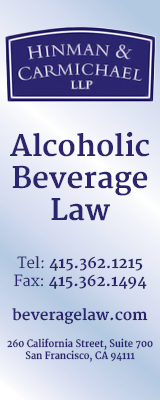FREE! Subscribe to News Fetch, THE daily wine industry briefing - Click Here
![Banner_Xpur_160x600---Wine-Industry-Insight[63]](/wp-content/uploads/Banner_Xpur_160x600-Wine-Industry-Insight63.jpg) |
 ALSO SPONSORED BY: 
Wine Industry Insight |
 |
Wine Institute Facing Changed Industry Climate
This article is the first in a series on California’s Wine Institute.
The Wine Institute is the nation’s oldest and largest wine trade association, having represented California vintners since 1934.
Despite its preeminence and longevity, it is facing a changed competitive climate:
- California wines continue to lose market share to imports.
- The Institute itself grows less representative of the state’s wineries with a smaller percentage of the state’s vintners than it has in at least the past 20 years. See separate article: Wine Institute’s Shrinking Representation Of California
- The emergence of a new and powerful anti-alcohol movement building on the work of the U.S. Centers for Disease Control and the World Health Organization which have redefined as “heavy” or “excessive” the same alcohol consumption levels once designated as “moderate” in scores of peer-reviewed, published scientific papers. The Wine Institute is less prepared for that because, in 2006, it eliminated its research and education department that provided access to scientific journals and articles for journalists and others interested in the “French Paradox” issue.
Even with a $20 million annual budget and 45 employees who are generously but appropriately compensated, the Wine Institute continues to provide data on its web site that are frequently outdated, incomplete and lacking in context.
Likewise it falls short in overall transparency and responsiveness as compared with other alcoholic beverage associations such as the Distilled Spirits Council of the United States (DISCUS) and The Beer Institute which have smaller association budgets, larger market shares and enormous amounts of current, detailed data available to the public.
Wine Institute Shuts Out Wine Industry Insight For Un-tenor-able Questions
This series was written without the assistance of the Wine institute which said it would not cooperate because it did not like the “tenor” of Wine Industry Insight’s questions (See more at: Un-tenor-able Questions).
Because of that, the data attributed to the Wine Institute in this series of articles, are based on statistics available at its web site, and in its IRS Form 990s.
Additional data comes from the TTB, USDA, published data from Gomberg Fredrikson, DISCUS, The Beer Institute and other third-party sources whose statistics are frequently more current, complete and — just as importantly — easily available.
A statistics spreadsheet, (portions of which are excerpted as charts in this article series), will be available for download by Wine Executive News premium subscribers in the final article installment.
U.S. Wine Per Capita Consumption Up Nationally, California Sales Increases Lag

Excerpt from original Wine Industry Insight Excel spreadsheet containing a large number of new correlations and calculations. Spreadsheet available to premium subscribers at the end of the series.
According to the U.S.Census Bureau and statistics available on the Wine Institute’s web site, U.S. per capita wine consumption increased 145% from 1998 to 2013. That reflects a growth in total population of 117% and total wine consumption growth of 170% (all numbers rounded up or down to nearest whole percent).
A closer look at those numbers shows that California lagged behind the consumption increase with a volume growth of 133% versus the overall 170% total growth.
Wine Executive News subscribers please click here to read the complete article and data charts.
Also In This Article:
The full text of the following sections as well as all the data charts are available to premium subscribers of Wine Executive News.
California Wine Market Share By Volume Continues Nose Dive

Excerpt from original Wine Industry Insight Excel spreadsheet containing a large number of new correlations and calculations. Spreadsheet available to premium subscribers at the end of the series.
California Wine Market Share By Revenues Decline But Not As Badly As Volume

Excerpt from original Wine Industry Insight Excel spreadsheet containing a large number of new correlations and calculations. Spreadsheet available to premium subscribers at the end of the series.
California Per Gallon Value Increase Offers Wine Some Consolation

Excerpt from original Wine Industry Insight Excel spreadsheet containing a large number of new correlations and calculations. Spreadsheet available to premium subscribers at the end of the series.
Wine’s Market Share Of Total Alcohol Revenue Is Flat As Spirits Climb, Beer Falls
According to the DISCUS total supplier gross revenues of all alcoholic beverages in the United States totaled $65.8 billion in 2014.
Wine’s share of that remained flat at 17% in 2014. The US wine market share was 16.6% in 2005.
With wine’s market share flat, spirits has gained at the expense of beer.
Coming Monday: Aided By USDA Funding, Calif Wine Exports Continue Success Despite 2014’s Stumble
Not a Wine Executive News subscriber?
Subscribe to Wine Executive News now, and get the rest of this original article along with everything else on the site every day, including original documents, spreadsheets,and source materials for just $24.99 per month or $189 per year.
IMPORTANT NOTE: Subscribers never, ever pay a higher rate — regardless of price increases — for as long as they continually maintain their subscription. The first subscribers from eight years ago are still paying $99/year, not $189.






